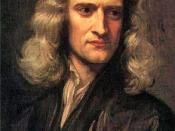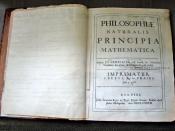Introduction
Newtonian dynamics is considered to be the foundation of motion in modern physics. Even though there were many scientist and philosophers before Newton, he was the one able to put all the theories together to come up with the law of inertia. Newton was influenced by other great people such as Descartes, Galileo, and even Aristotle. In Section 1 - Newtonian Dynamics, there will be an explanation on Newton's ideas about inertia. Section 2- Descartes Philosophy, show the similarities between Newton's and Descartes' ideas of motion. Section 3- Galileo's Principle, shows Galileo understanding of inertia and how it created a foundation for Newton's later discoveries of motion. Section 4 - Aristotle's Theory of Projectile Motion, shows Aristotle's views on projectile motion and how Newton presents a different idea of the movement of projected objects.
Newtonian Dynamics
The concept of inertia In Newtonian dynamics is well known in today's society and understood greatly amongst many people that study physics and various other sciences.
As we know, inertia is a property of all matter. In Newtonian dynamics, Inertia is stated Isaac Newton's first law, "that an object remains at rest or in uniform motion unless a force acts on it". In this condition, when a pencil is on a table, the pencil won't move unless a force acts upon it. His second law can reconfirm this, F=ma, Force is equal to the mass of an object multiplied by the acceleration of the object. If there is no force acting upon an object (when force equals 0), there will be no acceleration. Even though there is no force acted upon the object, if the object is still in motion and the force is equal to 0, it will continue to in that motion until a force (such that it be a...


